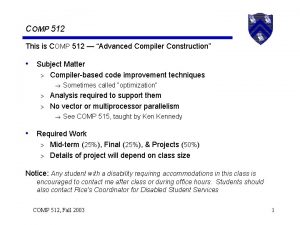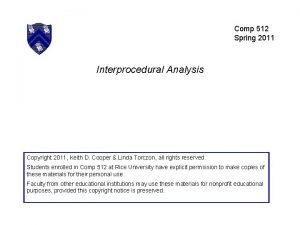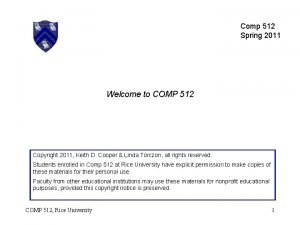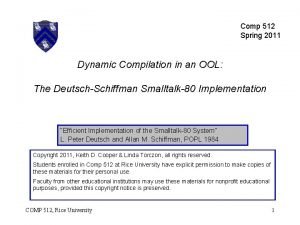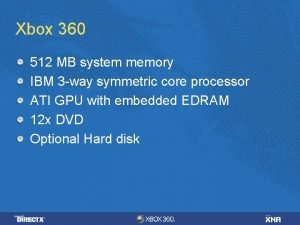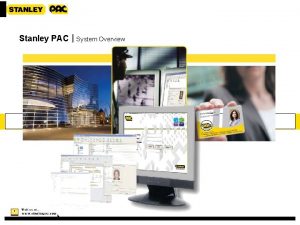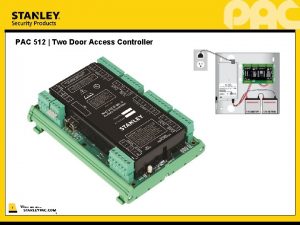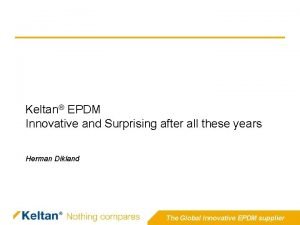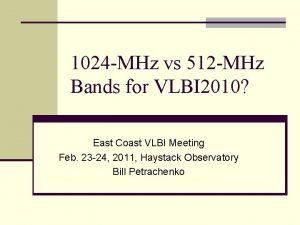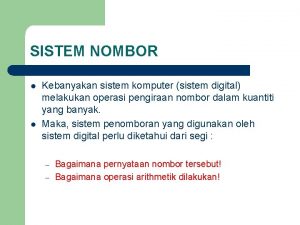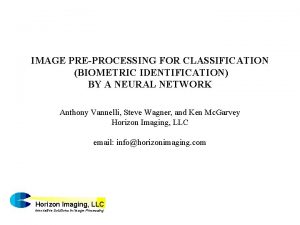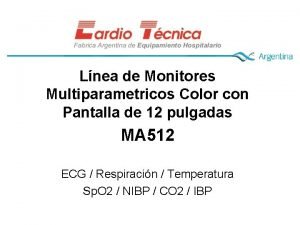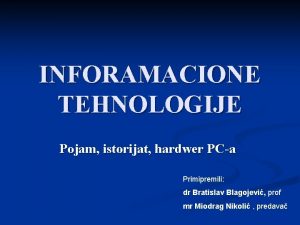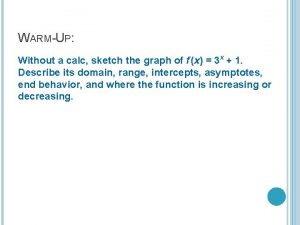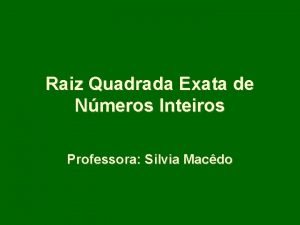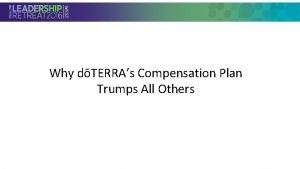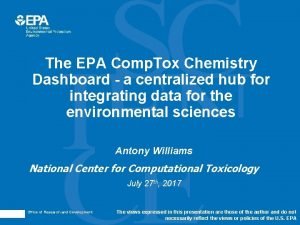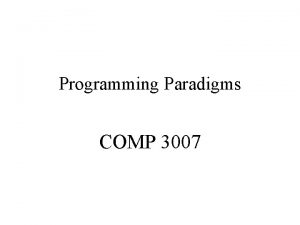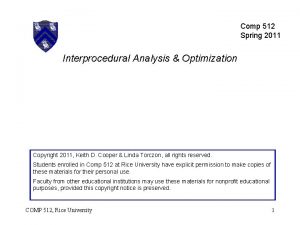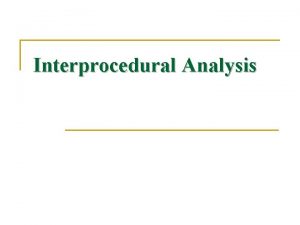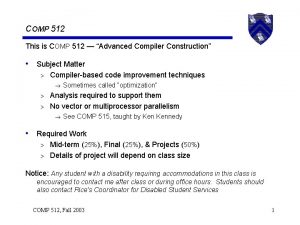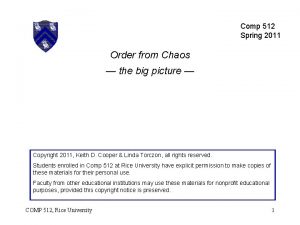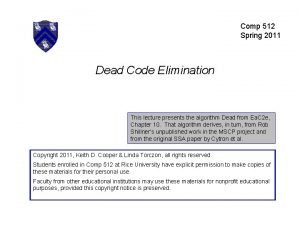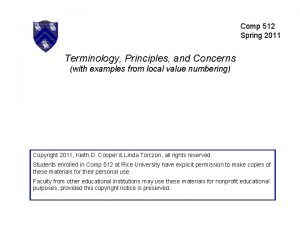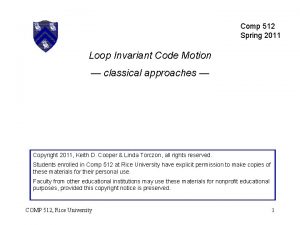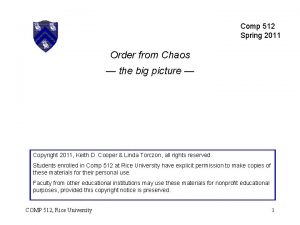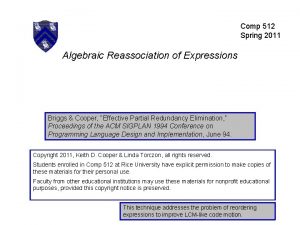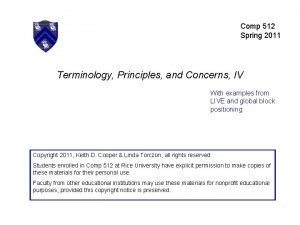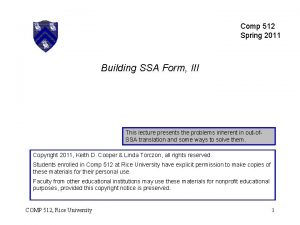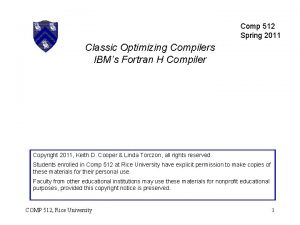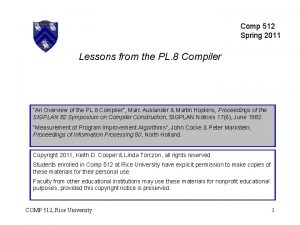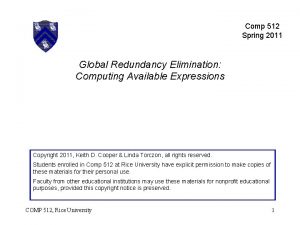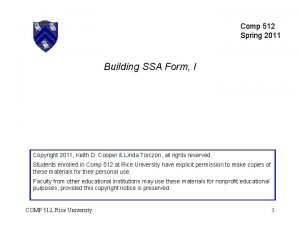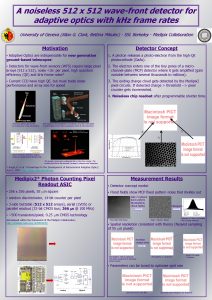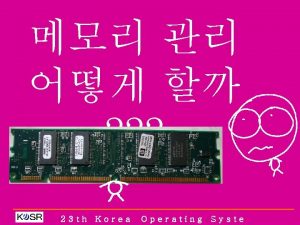Comp 512 Spring 2011 Interprocedural Analysis Copyright 2011



























- Slides: 27

Comp 512 Spring 2011 Interprocedural Analysis Copyright 2011, Keith D. Cooper & Linda Torczon, all rights reserved. Students enrolled in Comp 512 at Rice University have explicit permission to make copies of these materials for their personal use. Faculty from other educational institutions may use these materials for nonprofit educational purposes, provided this copyright notice is preserved.

Motivation Why consider analysis & optimization of whole programs? 1. To produce better code around call sites > Avoid saves & restores > Understand cross-call data flow 2. To produce tailored copies of procedures > Often, full generality is unneeded > Constant-valued parameters & globals, aliases 3. To provide sharper global analysis > Improve on conservative assumptions > Particularly true for global variables Perception is that calls are expensive (& disruptive) 4. To present the optimizer with more context > Languages (& programs) with short procedures > Assumes that context improves code quality COMP 512, Fall 2001 2

Interprocedural Analysis & Optimization Whole program compilation • Old ideas • Trendy subject { Automatic detection of parallelism Link-time analysis & optimization Component technologies • Interprocedural analysis > Control-flow analysis (derive a call graph) > Data-flow analysis > Estimating execution frequencies • Interprocedural optimization > Inline substitution & procedure cloning > Activation record merging, cross-jumping, … • Recompilation analysis COMP 512, Fall 2001 3

Fact versus Folklore: Create a single large graph & optimize it all • Get all the benefits of analyzing the whole program • See all the opportunities • This should show the upper bound on improvement Fortran H limited analysis to 996 names, with 2 bits for the rest Fact: The details get in the way • Single procedure methods get overwhelmed with details > Imagine a data-flow analysis with all the names > Two choices–summarization or slow compilation And most of the detail is local Not clear that this approach leads to better code It does lead (inexorably ) to slower compilation > • • COMP 512, Fall 2001 (!? !) 4

Fact versus Folklore: Overhead of calls is significant • For small procedures, linkage can dominate useful work • Should eliminate calls whenever possible (avoid the cost ) • Lead scientific programmers to non-modular style Fact: Calls have costs, but they also have benefits • Actual costs are a function of procedure size and call frequency • Calls provide a much needed separation of concerns > Imagine nesting all those register lifetimes > Imagine using a spill-everywhere allocator! > Few allocators have the courage to spill everything • Eliminating calls can slow the code down COMP 512, Fall 2001 5

Fact versus Folklore: Modular codes need interprocedural optimization • Higher ratio of calls to real work • Less straight-line code for optimizer Fact: Opportunities are limited • Smaller procedures have smaller name spaces > Fewer interactions to improve > Fewer common overheads, like address expressions • Procedure call optimization is more important Calls take a larger fraction of the time > Inline calls to eliminate linkages & create context > Avoid copying & de-referencing parameters > COMP 512, Fall 2001 6

What are the problems? Scoping effects limit opportunities for improvement • Intraprocedural methods assume a common name space > Redundancy elimination must “see” definitions > Constant propagation must “know” values • Entry & calls tap into an unknown environment • Formal actual mapping is onto, not one-to-one At source level, only formals & globals interact across procedures! • Modularity limits use of globals • Call-by-value forces values through memory • Modular programs may be inherently less efficient! Fortran may be the best case scenario ! COMP 512, Fall 2001 7

What are the problems? Different calls to p have different properties • Frequency of the call • Environment that p inherits > Mapping from parameters to value (& locations) Constant values & known values > Size of task Surrounding execution context > Is call in a parallel loop? > Which registers are unused? Procedure-valued parameters (OOP) > • • n m 10 1, 000 p May want to optimize distinct calls differently > Consider simple issue, such as caller-saves vs. callee-saves COMP 512, Fall 2001 8

What are the problems? Profitability Inlining eliminated • > 89% dynamic calls • > 75% static calls Unpredictable results In real life, its hard to pick the right strategy • Combination of program, compiler, input data • No single strategy fits all cases COMP 512, Fall 2001 Many commercial groups have secret (bad) anecdotes about inlining! Cooper, Hall, & Torczon, S–P&E, June, 1991 * 9

What are the problems? Compilers are engineered objects • Implementations contain unwritten assumptions > Code shape > Finite data structures • Call sites provide some great big hints Limit the global impact of local effects > Break lifetimes & reset analysis Smaller procedures map more easily onto small resources > 32 (or 32 + 32) registers > Less control-flow better knowledge > • Separation of concerns • Global optimization work well with plentiful resources • In larger scopes, resources are taxed & separation breaks down COMP 512, Fall 2001 10

What are the problems? procedure joe(i, j, k) procedure main l 2*k call joe( 10, 1000) if (j = 100) Since j = 100 this procedure ralph(a, b, c) always executes then m 10 * j then clause b a * c / 2000 else m i call ralph(l, m, k) With perfect knowledge, the compiler o mthis * 2 with could replace and always m has the value 1000 q 1000, 2 1000, 2000 write call ralph(o, q, k) and the rest is dead ! write q, m, o, l What happens at a procedure call? What value is printed for q? Did ralph() change it? • Use worst case assumptions about side effects • Leads to imprecise intraprocedural information • Leads to explosion in intraprocedural def-use chains COMP 512, Fall 2001 * 11

Interprocedural Analysis The compiler needs to understand call sites • Limit loss of information at calls • Shrink intraprocedural data structures > Def-use chains in PFC • Solve simple intraprocedural problems > Shadow loop indices in Fortran Interprocedural effects limit intraprocedural analysis • Grove & Torczon showed major impact of call sites on SCCP > Each call site killed many potential constants • Knowledge about modifications eliminated most of it COMP 512, Fall 2001 12

Interprocedural Analysis Definitions • May problems describe events that might happen in a call May Modify sets include any name the call might define > May Reference sets include any name the call might use > • Must problems describe events that always happen in a call > Must Modify set describes KILLs Computation can consider or ignore control-flow in procedure • Flow-insensitive analysis ignores intraprocedural control-flow • Flow-sensitive analysis tracks intraprocedural control-flow In the presence of aliasing and recursion, flow-sensitive analysis problems Some combinations don’t make sense are either NP-complete must or Co-NP complete > Flow-insensitive modify sets? (Eugene Myers, 8 th POPL) COMP 512, Fall 2001 * 13

Interprocedural Analysis Classical Problems have appeared in the literature • • • Constructing the call graph May summary problems – MAYMOD & MAYREF Alias tracking – MAYALIAS Constant propagation Kill information – MUSTMOD New-fangled problems appear all the time • Alignment propagation for caches • Propagating data distributions for FORTRAN D • Placing instrumentation & picking checkpoints COMP 512, Fall 2001 14

Constructing the Call Graph Complication is procedure-valued variable Solution: Ryder, 1979 (non-recursive Fortran) • Build subgraph described by literal constants • Propagate sets of values for procedure variables • Complexity is linear in size of call graph Handling recursion Build a precise graph O(N + PECP) logical steps > Conservative, approximate graph > O(NEp 2 P + d Ep. EP) bit-vector steps • Callahan, Carle, Hall, Kennedy (87 & 90) • Burke (87) • Hall, Kennedy (90) COMP 512, Fall 2001 > > Conservative, approximate graph O(N + PE) logical steps * 15

Constructing the Call Graph procedure main call confuse(a, c) call confuse(b, d) main confuse procedure confuse(x, y) call x(y) procedure a(z) call z() a b c d procedure b(z) call z() procedure c() … procedure d(). . . COMP 512, Fall 2001 Imprecise Precise callgraph 16

Constructing the Call Graph All of these algorithms assume Fortran • Newer ones include recursion (C) • No procedure-valued functions (no return) • Calls to variables are textually obvious More complex situations • • Assignment to procedure-valued variables Procedure-valued functions Arithmetic on procedure-valued functions Object-oriented programs > Value-based bindings • Dynamic construction or naming of procedures COMP 512, Fall 2001 17

Summary Problems MOD: v MOD(s) executing s might change v’s value REF: v REF(s) executing s might use v’s value These formulations can be solved with a flow-insensitive method The equations GMOD(p) = IMOD(p) e = <p, q> be (GMOD(q)) REF has a similar formulation DMOD(e) = be (GMOD(q)) Where GMOD(p): variables that may be modified by an execution of p IMOD(p): variables that may be modified locally in p DMOD(s): variables that may be modified by call site s, ignoring aliasing How quickly can we solve this data-flow problem? COMP 512, Fall 2001 Cooper & Kennedy, PLDI 88, June, 1988 * 18

Interprocedural Analysis is Hard Problems are neither fast nor rapid for structural reasons fee(a, b, c, d, e) { • • • call fee(local, a, b, c, d) • • • e = fie(e) } v w x y z a b c d e main fee local call fee(v, w, x, y, z) The shift register Call graph Parameter binding graph, Discovering whether or not v is modified when passed to fee takes time proportional to paths in the binding graph, not the call graph. COMP 512, Fall 2001 Assume call by reference parameters * 19

Interprocedural Analysis is Hard Problems are neither fast nor rapid for structural reasons fee(a, b, c, d, e) { • • • call fee(local, a, b, c, d) • • • e = fie(e) } v w x y z a b c d e main fee local call fee(v, w, x, y, z) The shift register Call graph Parameter binding graph, Time bound is often expressed with a term for the maximum number of formal parameters passed at any call site (a small constant ? ) COMP 512, Fall 2001 Assume call by reference parameters 20

Interprocedural Analysis is Hard Worst case patterns do appear Consider a hand-coded, recursive-descent, expression parser • Call graph is a complete graph main (almost) • Same parameters for each routine (almost) expr term factor • Binding graph is full (almost) For any characterization (almost), some real program has worst case properties Call graph COMP 512, Fall 2001 Assume call by reference parameters 21

Alias Analysis Definition When a memory location can be accessed by > 1 name, those names are said to be aliases of each other The Approach • Factor base problem into alias-free solution + ALIAS sets • Combine two to solve the base problem • ALIAS set tracks effects of parameter binding Strategy • Identify sites that introduce aliases • Propagate pairs of aliases around { 1. a “global” variable is passed as an actual parameter 2. a single name is passed in > 1 parameter positions p the call graph COMP 512, Fall 2001 Cooper & Kennedy, 16 th POPL, January, 1989 22

Constant Propagation The Problem Annotate each procedure with a set CONSTANTS(p) that contains < name, value > pairs important effects to model AThree completely different approach: Approximate the answers & discover a useful subset of the precise answer. 1. Constant values in available at call sites Conditional This is. Constant a compiler class, not a Wegman & Zadeck, their work on Sparse class! Propagation, suggest constant propagation by > Deriving initialperforming informationall interproceduralcomputability inlining during intraprocedural constant propagation. 2. Transmission of values across call sites > Interprocedural data-flow This will work, but involves all the propagation problems of inlining and compiling very large procedures. of The idea through is not completely 3. Transmission values procedurepractical. bodies > Intraprocedural model of execution (jump function) We could consider, however, doing this for the purposes of analysis. It would yield a large set of constants. The problem, however, is that mapping those Unfortunately, is either undecidable or intractable its most constants back each onto the non-inlined program may requireinsome deep reasoning and/or additional general and precise form transformations. COMP 512, Fall 2001 * 23

Constant Propagation Three important effects to model 1. Constant values available at call sites > Perform local constant propagation to find values > Use results as initial information 2. Transmission of values across call sites > Model this with an iterative data-flow framework > It will behave, but must use lattice depth to prove time bound 3. Transmission of values through procedure bodies > Can imagine many schemes for handling this issue > Values transmitted forward & backward > Approximate procedure’s behavior with jump functions COMP 512, Fall 2001 (returns) 24

Constant Propagation Jump functions • Varying levels of complexity • Use return jump functions for parameters & global variables • Use summary information (MOD) in jump function bodies Given a set of jump functions • Can use a simple iterative data-flow solver • If support of jump function is bounded, have a linear time bound • As in SCCP, values are either TOP, BOT, or ci Callahan, Cooper, Kennedy, & Torczon, SIGPLAN 86, June 1986 COMP 512, Fall 2001 Grove & Torczon, PLDI 93, June 1993 25

Pointer Disambiguation Problem is quite hard • Intraprocedural analog is harder than SCCP • Problem is inherently interprocedural Two competing formulations • ALIAS formulation (tuples of aliased pointers) • POINTS-TO formulation • Propagation involves modeling effects of assignments Other complications • Many values have no explicit names (malloc() ) • Syntax obscures their types, sizes, and other attributes COMP 512, Fall 2001 26

What Mechanisms are Needed? Analyzer needs access to entire program’s text Three alternatives • Programming environment, like Rn Compiler can access text as needed > Compiler can analyze compilation dependences > • Classic compiler and a program repository > (Convex ) Simplified version of Rn • Link time analysis & optimization Redo entire analysis & optimization on every compile > No change to programming model > COMP 512, Fall 2001 27
 Comp 512
Comp 512 Comp 512
Comp 512 Comp 512
Comp 512 Comp 512
Comp 512 Kim ki duk spring summer fall winter
Kim ki duk spring summer fall winter What months are in spring
What months are in spring Ecisd spring break 2011
Ecisd spring break 2011 360/512
360/512 Dts gate motor 4 beeps
Dts gate motor 4 beeps Stanley pac 512
Stanley pac 512 Pac reader wiring diagram
Pac reader wiring diagram Keltan 8550c
Keltan 8550c 2560/512
2560/512 Sistem nombor oktal
Sistem nombor oktal What is 3 512?
What is 3 512? 16000/512
16000/512 512 x 160
512 x 160 512 cc
512 cc Idaho code 33-512
Idaho code 33-512 Ma-512
Ma-512 Pca 512 instrukcja
Pca 512 instrukcja Evaluate log
Evaluate log 16000/512
16000/512 Raiz de 256
Raiz de 256 Plexus ranks
Plexus ranks Comp tox
Comp tox Ap csa recursion
Ap csa recursion Comp3007
Comp3007
